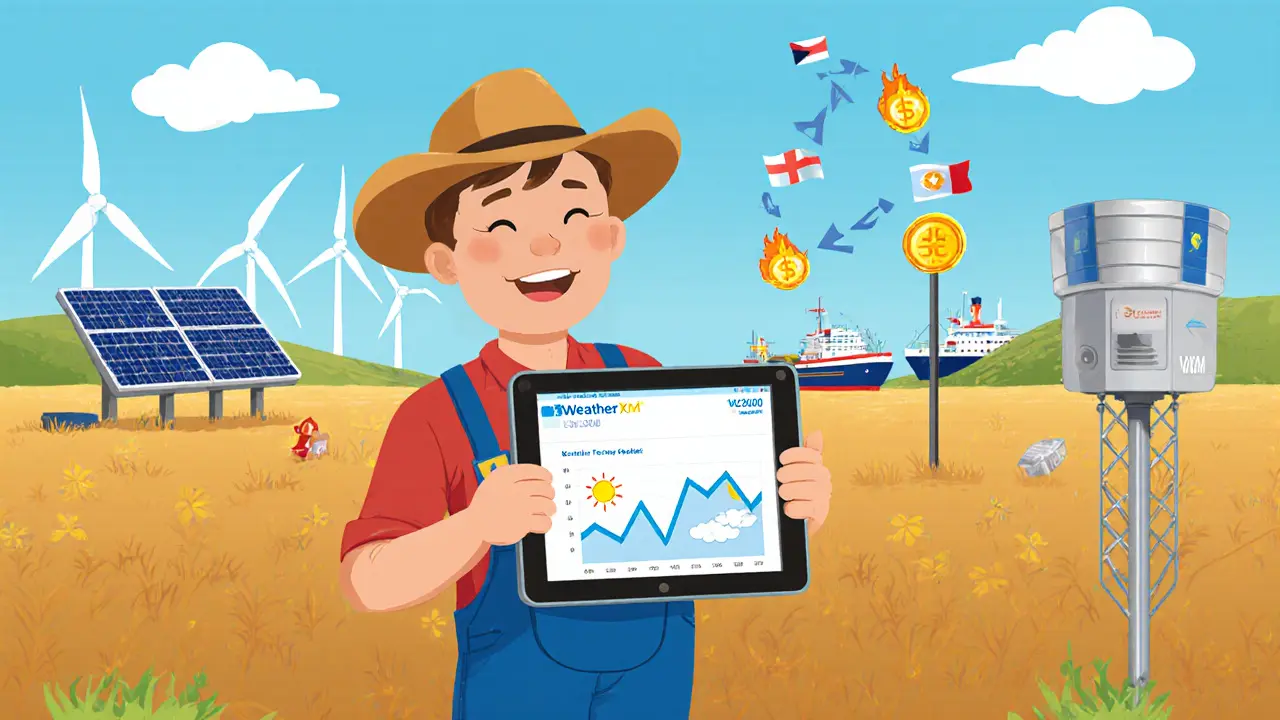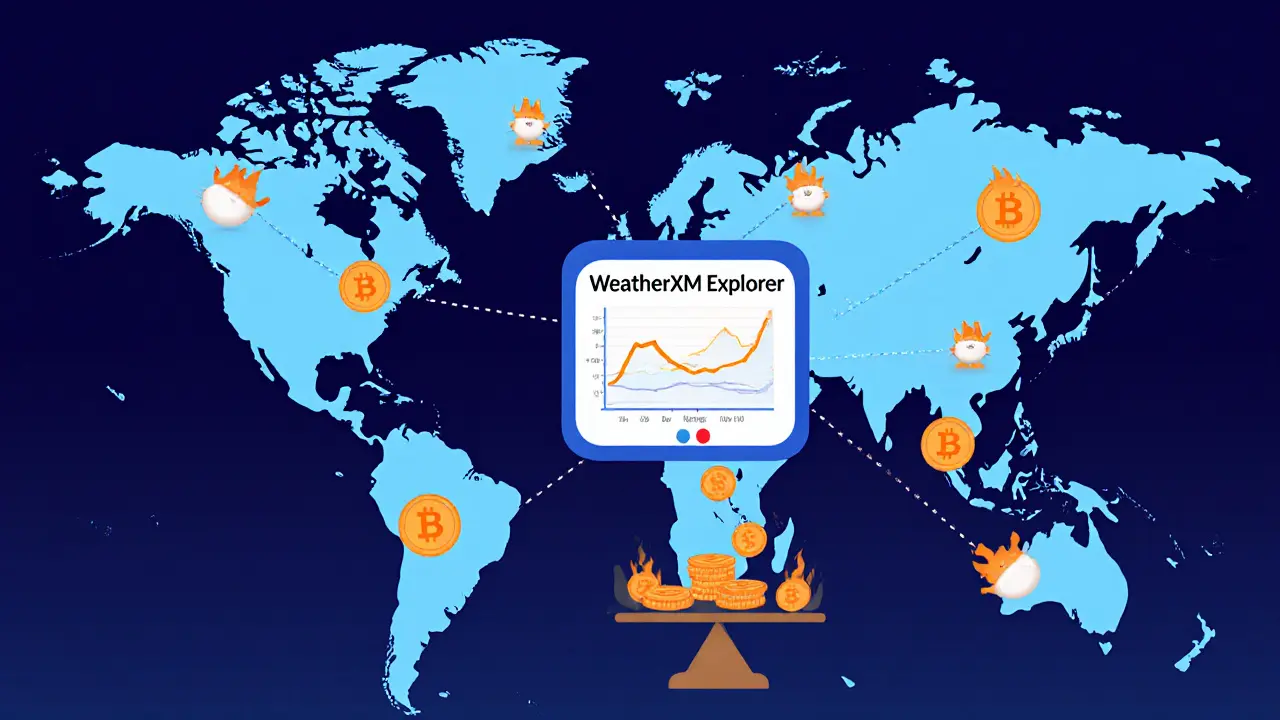
- 21 Oct 2024
- Elara Crowthorne
- 13
WeatherXM (WXM) Token Value Calculator
Current Market Info
Current WXM Price:
Daily Token Distribution:
Total Circulating Supply:
Your Station Performance
Estimated Earnings
Daily WXM Reward:
0 WXM
Total WXM Earned:
0 WXM
USD Value (at current rate):
$0.00
Performance Rating:
Excellent
Ever wondered why a weather station could earn you crypto? WeatherXM token is the digital fuel behind a global, community‑run weather‑data network. Think of it as a mix between a tiny personal weather hub and a Bitcoin‑style reward system, all tied together on a blockchain that scales on Arbitrum One. If you’re curious about how the token works, what you can do with it, or whether it’s worth a look, this guide breaks it down in plain English.
Key Takeaways
- WeatherXM (WXM) is an ERC‑20 token that powers the world’s largest decentralized weather‑data network.
- Station owners mine WXM by submitting high‑quality, hyper‑local weather data to the blockchain.
- Token economics rely on a “burn‑and‑mint” model using USD‑pegged Data Credits (DC) to balance supply and demand.
- You can join by buying a WS2000 Weather Station for $500 or 700WXM tokens.
- The network serves agriculture, renewable energy, maritime, and other industries that need precise, on‑the‑ground forecasts.
What is WeatherXM?
WeatherXM is a decentralized weather network launched under the broader DePIN (Decentralized Physical Infrastructure Networks) movement. The project’s legal backbone is the WeatherXM Network Association, which issued the native WXM cryptocurrency. While the token started on Ethereum L1, the rewards now flow on Arbitrum One to keep transaction fees low and throughput high.
In just two years the network has deployed over 5,200 WS2000 Weather Stations in 81 countries. Each device measures temperature, humidity, solar radiation, air pressure, wind speed & direction, and precipitation. The data is sent via low‑power LoRaWAN radios, often piggy‑backing on the Helium network gateways, so owners only need a simple plug‑and‑play setup.

How Does the WXM Token Work?
The token economy revolves around a “burn‑and‑mint” equilibrium. Users who need weather data purchase Data Credits (DC), a USD‑pegged unit. DCs are bought with WXM, and when data is delivered the corresponding DCs are burned, pulling WXM out of circulation. On the supply side, station owners earn WXM each day for uploading verified, high‑quality data. A smart contract allocates a fixed daily budget of tokens, then distributes it based on data‑quality scores and uptime.
This loop keeps the token’s price tied to real‑world demand: more data consumers → more DC purchases → more WXM burned → scarcity → price pressure upward. As of October2025 the market price sits around $0.093 per token, with a 24‑hour volume near $80k, placing it in the mid‑range of crypto assets (rank #4376 on CoinMarketCap).
How to Join the Network
- Buy a WS2000 Weather Station. You can pay $500 USD or use 700WXM at a discount offered by partners like SwissBorg.
- Set up the station. The hardware snaps together in 10‑20minutes, connects to the nearest Helium gateway, and starts sending data automatically.
- Configure a crypto wallet (MetaMask on Arbitrum One works well) and link it to the WeatherXM Explorer to claim your daily rewards.
- Monitor performance via the mobile app. The dashboard shows signal strength, data freshness, and earned WXM.
- Optional: Stake WXM in upcoming governance proposals or trade it on major DEXes for liquidity.
Technical know‑how is minimal-mostly basic Wi‑Fi or LoRaWAN concepts. The community forums and official docs provide step‑by‑step videos, so even a novice can get up and running.
Real‑World Use Cases
Because the network supplies hyper‑local, real‑time data, several verticals have started to integrate WXM‑backed feeds.
- Agriculture: Farmers buy short‑term crop‑insurance contracts that trigger payouts when the network records specific rainfall thresholds. This reduces paperwork and speeds claims.
- Renewable Energy: Wind‑farm developers use dense station clusters to model wind shear and pick optimal turbine sites, cutting costly site‑survey trips.
- Maritime: Ports receive minute‑by‑minute wind and pressure updates, allowing better berth scheduling and fuel‑efficiency calculations for ships.
- Insurance & Finance: Parametric insurance products are priced directly on DC‑purchased data, creating a transparent, tamper‑proof risk model.
All these applications rely on the same token‑incentivized data pipeline, meaning higher data quality translates into higher token rewards for station owners.

WeatherXM vs. Traditional Weather Providers
| Aspect | WeatherXM (DePIN) | Traditional Providers |
|---|---|---|
| Coverage Density | Hyper‑local, community‑driven stations (average 1‑2km grid) | Sparse, often national‑level stations (10‑50km grid) |
| Cost to Access Data | Pay with Data Credits (DC) or earn via token rewards | Subscription fees, often high for premium APIs |
| Data Transparency | On‑chain visibility via WeatherXM Explorer | Proprietary databases, limited public visibility |
| Incentive Model | Earn WXM for high‑quality submissions | No direct financial incentive for contributors |
| Scalability | Arbitrum One + LoRaWAN keeps fees low | Legacy infrastructure, slower updates |
The table shows why many startups and developers favor WeatherXM when they need data that’s both granular and affordable.
Risks & Considerations
Like any crypto‑project, WeatherXM carries specific risks. Network coverage can be spotty in regions without enough Helium gateways, leading to intermittent data uploads. Token price volatility means that the USD value of your mining rewards can swing sharply. Regulatory uncertainty around crypto‑based data marketplaces could affect future adoption. Finally, early‑stage projects sometimes experience delays in token distribution-some community members reported a few weeks of backlog during rapid scaling phases.
Mitigation strategies include diversifying your station locations, holding a portion of earned WXM in a stable‑coin vault, and staying active in the governance forums to vote on protocol upgrades.
Frequently Asked Questions
What is the primary purpose of the WXM token?
WXM fuels the WeatherXM ecosystem. It’s used to buy Data Credits for accessing weather data, rewards station owners for uploading accurate information, and participates in network governance.
Do I need technical expertise to run a WS2000 station?
Not really. The WS2000 is plug‑and‑play. You just mount it, power it, and let it connect to the nearest Helium gateway. Basic Wi‑Fi or LoRaWAN knowledge helps, but the community guides cover everything.
How are WXM tokens minted and burned?
Tokens are minted daily from a fixed supply pool and awarded to stations based on data quality. When users purchase Data Credits, the equivalent amount of WXM is burned, keeping the overall supply in balance.
Can I trade WXM on centralized exchanges?
WXM is listed on several decentralized exchanges on Arbitrum, and a few centralized platforms have added it as a low‑volume pair. Liquidity is still growing.
What’s the future roadmap for WeatherXM?
The team plans to launch token‑based governance, expand station deployment in underserved regions, introduce data‑license auctions, and add new IoT sensor types like air‑quality monitors.

13 Comments
WeatherXM’s token model distributes a fixed daily supply of 1,000,000 WXM, which is then split among active stations based on their quality scores and uptime. The circulating supply sits around 100 million tokens, so each token’s market cap is modest relative to its utility. Higher data quality and longer active periods translate directly into more WXM rewards. In short, the token incentivizes reliable, high‑quality weather data contributions.
Okay, let’s break this down step by‑step, because the crypto world loves to hide the real agenda behind flashy UI elements. First, the WXM token claims to be “decentralized,” but the daily emission of one million tokens is set by a central governance board that can tweak the numbers at any time. That means the supply isn’t truly immutable; it’s just a moving target for the uninitiated. Second, the token price you see ($0.093) is a snapshot controlled by a few large whales who hold a disproportionate share of the 100 million supply. Those whales can pump or dump the token whenever they please, manipulating the market for personal gain. Third, the reward algorithm rewards stations with the highest “data quality scores,” but those scores are calculated by proprietary software whose source code is hidden. If the algorithm is biased, it can favor stations owned by insiders, funneling more tokens to a select few. Fourth, the daily distribution model creates an inflationary pressure that erodes token value over time, especially when the network expands and more stations join the ecosystem. Fifth, the whole premise of incentivizing weather data with crypto might sound noble, but remember that weather data is already a public good-why monetize it? Sixth, there are rumors that the token is being used to fund other off‑grid projects that have little to do with weather reporting, a classic case of mission‑creep. Seventh, every time you click the “calculate” button, you’re feeding data to a server that logs your IP address and potentially your location, raising privacy concerns. Eighth, the token’s smart contract has a built‑in “owner” address that can pause withdrawals, effectively freezing users’ assets on demand. Ninth, the whitepaper mentions a “decentralized oracle network” but provides no concrete technical details, which is a red flag for many crypto‑savvy analysts. Tenth, if you look at the GitHub repo, it hasn’t been updated in over a year, suggesting stagnant development. Eleventh, the community forums are riddled with spam and bots that push hype instead of genuine discussion. Twelfth, the token’s market cap is under $10 million, which makes it extremely vulnerable to market manipulation. Thirteenth, the reward system does not account for regional weather variability, meaning stations in quiet climates get penalized. Fourteenth, the token economics assume a steady influx of new participants, which is unsustainable without continuous marketing spend. Finally, always remember that if something sounds too good to be true, it probably is, especially in the wild west of crypto weather tokens.
Wow! This is absolutely fantastic! 🎉 WeatherXM is really stepping up the game!!! The idea of rewarding accurate weather stations is brilliant; it encourages community participation, data reliability, and a greener future!!! Keep up the amazing work, everyone!!!
From a cultural perspective, the decentralization of weather data aligns with the broader movement toward open knowledge sharing across societies. By granting token incentives, WeatherXM empowers local contributors, especially in under‑represented regions, to have a voice in global climate monitoring. The tokenomics, while still evolving, appear to balance supply‑side inflation with demand generated through utility. This model could serve as a template for other community‑driven data projects, fostering both transparency and engagement.
Great initiative! If you keep your station online and maintain a high data quality score, the WXM rewards will add up nicely over time. Remember, consistency is key-regular uptime and accurate readings will boost your earnings. Keep it up, and you’ll see the token value grow along with your contributions.
Look, the whole thing sounds fishy. They say it’s decentralized, but who really controls the token flow? It could be a front for other hidden agendas. Stay alert, and don’t hand over your data without questioning the motives behind it.
Nice setup.
From a systems architecture standpoint, the token reward pipeline leverages a DAG‑based consensus mechanism to ensure low‑latency verification of station submissions. By integrating off‑chain data attestations, the protocol mitigates on‑chain bloat while preserving cryptographic integrity. This hybrid approach is essential for scaling weather data networks without sacrificing security.
Ah, the classic illusion of decentralization-an elegant veneer over a centralized power structure; a construct that reassures the masses whilst consolidating control within a privileged few; the tokenomics, with their perpetual emissions, serve as a reminder that true liberty is often masked by the promise of profit.
The model is overly simplistic and fails to address the inherent variability in regional weather patterns; rewarding stations solely on uptime and a generic quality metric overlooks critical nuances and may incentivize data homogenization.
Oh great, another token that pretends to solve climate data problems while developers chase shiny tokenomics. If only the hype matched the actual utility, we might have something worth talking about.
i think its cool but also kinda scary lol. if the token price goes up, ppl will try to cheat the system. hope they keep an eye on it.
In accordance with the principles of transparent governance, I would recommend that the WeatherXM community establishes a formal proposal mechanism for token emission adjustments. Such a process would ensure that all stakeholders have an equitable opportunity to participate in decision‑making, thereby reinforcing the network’s decentralized ethos.